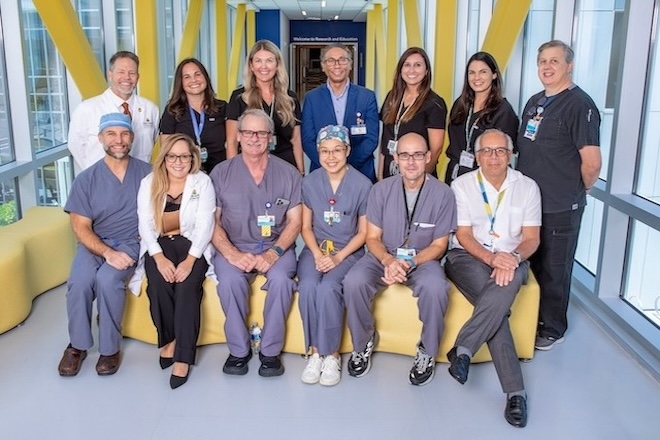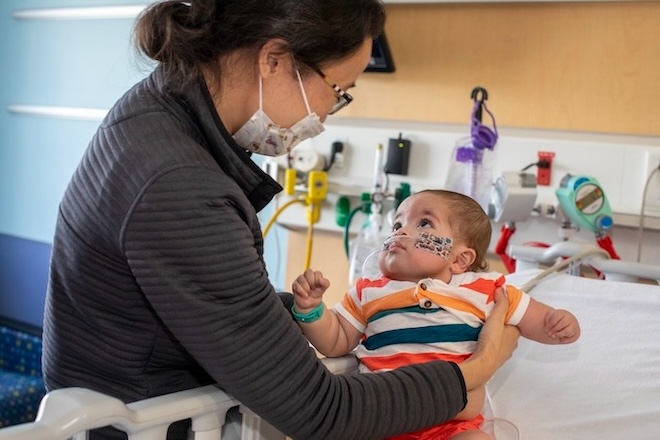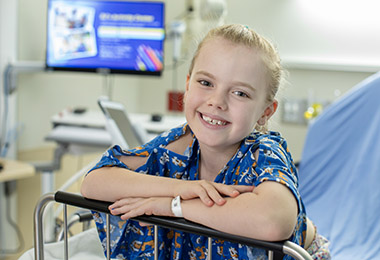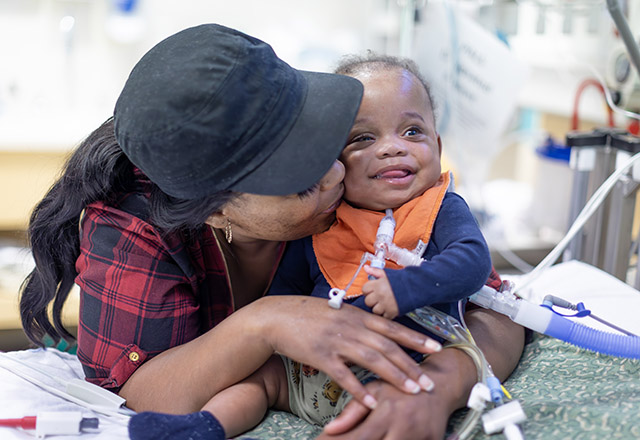The Esophageal and Airway Treatment (EAT) Program at Johns Hopkins All Children’s Hospital in St. Petersburg, Florida, cares for infants, children and young adults with complex esophageal and airway problems.
Led by esophageal and airway expert Jason Smithers, M.D., our dedicated team combines compassionate care, innovative techniques and cutting-edge technology and equipment to treat babies and children with esophageal and airway concerns.
Our team believes every patient should have more than 80 years of good esophageal and airway function. That’s why we customize every patient’s care plan for the best results. For cases of esophageal atresia or strictures, we maintain the patient’s native esophagus for the best long-term outcomes.
Esophageal and Airway Conditions We Treat
Our team specializes in diagnosing and treating a variety of esophageal and airway concerns, including:
- Bronchomalacia. Bronchomalacia is a congenital problem caused by weak or poorly shaped cartilage in the walls of the bronchial tubes. There is often wheezing when breathing from the weakened cartilage collapsing during breathing.
- Esophageal atresia, including long gaps. Esophageal atresia is when a baby is born without part of the esophagus, causing the esophagus to grow in two segments that do not connect. In some cases, so much of the esophagus is missing that the ends can’t be easily connected. This is known as long gap.
- Esophageal injury, including caustic ingestion. A child’s esophagus can be injured by ingesting foreign objects or toxic substances such as detergents and drain cleaners. Depending on the severity of the substance ingested, children can develop burns, strictures or holes in their esophagus.
- Esophageal replacement. We use jejunal interposition with microvascular enhancement for esophageal replacement in cases where esophageal salvage is not possible.
- Esophageal strictures. Esophageal strictures describes a narrowing of the esophagus. This can be present at birth or occur if the patient has gastroesophageal reflux or has had a surgery on his or her esophagus or if the esophagus is damaged from an injury or trauma.
- Hiatal hernia. In some cases, the muscles where the esophagus meet the stomach do not close tightly, leaving a large opening in the diaphragm. A hiatal hernia occurs when the upper part of the stomach bulges through this opening and into the chest.
- Tracheomalacia and other airway anomalies. Tracheomalacia is when the airway collapses during breathing or coughing, causing a child to have breathing difficulties. A child with tracheomalacia may also suffer from recurring respiratory illnesses. Long-term tracheomalacia can lead to lung injury.
- Tracheal diverticulum. Tracheal diverticulum is esophageal tissue on the trachea. This pouch-like tissue is often from undergoing surgery to repair esophageal atresia with tracheoesophageal fistula (TEF). Left untreated, this tissue could trap secretions and increase the chances of lung infections, lead to recurrent TEF and could lead to collapse of the trachea.
- Tracheoesophageal fistula (TEF), including recurrent TEF. A tracheoesophageal fistula is an abnormal connection between the esophagus and the trachea.
- Vascular rings causing tracheal or esophageal compression. Vascular rings refer to a variety of abnormalities in the chest that involve the heart’s major blood vessels and result in compression of the trachea and/or esophagus.
Our Procedures
Our team is specially trained in both open and minimally invasive procedures, including:
- Airway stents and splints, internal and external. Stents and splints temporarily hold the trachea open and encourages tissue to grow around it.
- Aortopexy, anterior and posterior. This procedure provides immediate and permanent relief for some types of tracheomalacia. In this procedure, the child’s trachea is opened up by moving the aorta towards the front and attaching it to the back of the sternum. Sometimes, in order to create more space between the aorta and the sternum, the thymus gland is removed.
- Bronchoscopy. A bronchoscopy is a procedure where doctors use a tool called a bronchoscope to examine a child’s throat, larynx, trachea and lower airways. This procedure is used to diagnose problems with the airways, lungs or lymph nodes.
- Foker process for long gap esophageal atresia. The Foker process is a procedure that encourages natural growth and lengthening of a child's existing esophagus.
- Jejunal interposition. Jejunal interposition is a procedure where the missing esophagus is replaced with a section of the jejunum (the middle part of the small intestine).
- Tracheopexy, direct anterior and posterior. This procedure opens up the trachea by suspending the front of the tracheal wall from the back of the sternum or the back of the trachea to the spine.
Learn more about our program
-
Meet Our Team
In addition to our expert care, we take a whole-team approach to treating conditions. Our team works alongside specialists and subspecialists across our hospital, including pediatric surgeons, gastroenterologists, otolaryngologists, pulmonologists, critical care physicians, nutritionists and speech/swallowing specialists and are ready to meet a patient's needs all in one location. Our program also specializes in transitioning pediatric patients to adult care and offers a long-term follow-up clinic.

-
Research
The Johns Hopkins All Children’s EAT program maintains a database to closely track short-term and long-term clinical outcomes. Our program is also helping to develop a national database registry to track and standardize outcomes across the United States. Additionally, our program is part of a consortium of esophageal referral programs studying the use of magnet-based esophageal growth and anastomosis for cases involving long gap esophageal atresia and severe esophageal strictures.

Contact Us
For more information about how our program can help your child or to make an appointment, please speak with the program's nurse coordinator by calling 727-767-3711.
You can also use our online contact form, and a member of our team will follow up with you to assist with your questions.

Read more:
-
Congenital Diaphragmatic Hernia and Type IV Laryngeal Cleft: Clara's Story
When a routine ultrasound showed that Tori and Josh’s baby had congenital diaphragmatic hernia, a recommendation from their doctor in Atlanta brought them to Johns Hopkins All Children’s. Once here, it was discovered that baby Clara also had a rare airway condition, necessitating care from the experts in the Esophageal and Airway Treatment Program.

-
Tracheomalacia: Vaida's Story
Vaida struggled with health issues all her life until she traveled half a world away for answers. Learn how the EAT team gave Vaida reason to dance.

-
Bronchopulmonary Dysphasia: Jahleel’s Story
Jahleel, born prematurely at 24 weeks gestation, weighing 1 pound, 11 ounces, had a chronic lung disease called bronchopulmonary dysplasia. He received specialized care from the experts on the Esophageal and Airway Treatment team.

-
Esophageal Atresia: Wynter's Story
Diagnosed with an esophageal atresia, a condition where the esophagus is not connected properly the stomach, Wynter received care from Dr. Jason Smithers and the team in the Esophageal and Airway Treatment Program.


